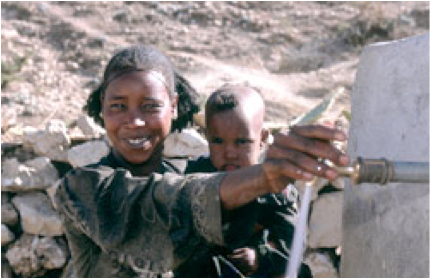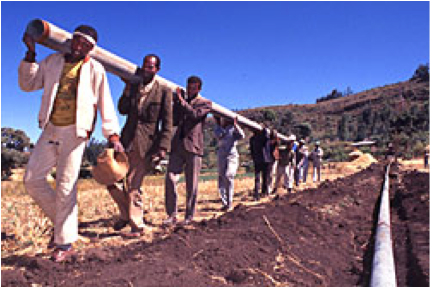Gravity-powered
A gravity-fed supply from a small upland river, stream or spring, impounded with a protected catchment, is a sustainable choice of accessing water. Using the force of gravity, water can be transported by pipework to tapstands placed near to homes, thus reducing the drudgery involved in carrying water a long way.
The capital costs of gravity schemes are, on average, higher than the cost of schemes which obtain water from underground sources. This is due mainly to the cost of long pipelines from the upland sources down to the villages and partly to the cost of providing storage tanks. Running costs are usually low, with regular maintenance needed only for replacing tap washers, cleaning screens, etc. Reliability is usually high and the level of service provided is good.
The usual components of a gravity scheme are the source (stream, spring catchment, dam, or intake), main pipeline, storage and break-pressure tanks, distribution pipelines and tapstands. The communities who benefit from the scheme are usually involved in large commitments of time and effort in the construction work associated with these components.
Suitable conditions
Regions where there is a difference in water height, e.g. mountainous regions.
Source
A source may have several elements:
Spring or stream
If a spring or stream is to be the source, it must be unpolluted and must flow throughout the year; the flow must be measured in the dry season in order to know what yield can safely be relied upon. When a spring is used, the spring head must be protected. The water must be piped directly from the eye of the spring to prevent any pollution affecting the supply.
Catchment
The catchment area of a spring or stream must be free of animals and cultivation. If only a small area is involved, it may be fenced off completely. Communities often enforce bylaws to exclude people and animals from the area.
Dams and intake
Dams in streams are generally small; their purpose is to provide a small pond so that a controllable draw-off pipe can be built into the wall of the dam at a level higher than the bed of a stream. Unlike larger dams, which impound water to provide storage over a dry season, these small dams overflow for most of the time. The crest of the dam acts as an overflow weir, except at the sides, where it is raised to prevent scouring of the banks.
A dam is usually constructed of concrete, blockwork or masonry, preferably founded on rock. Rock, or some other impermeable material, should also form the basin of the impoundment. Twin intake pipes (one in use, one in reserve) are built into the wall of the dam; on the upstream side of the dam, they have strainers or screens; on the downstream side they are fitted with control valves. A scour pipe is also built into the dam, at low level, with a stop valve on the downstream side, and is used periodically to drain the pond and to clear accumulated silt, etc.
Construction, operations and maintenance
Main pipeline
The route of the pipeline from the intake to the storage tank must be surveyed and a drawing made of the optimum hydraulic gradient line, in order to determine the pipe size needed to deliver the design flow. In rocky areas the pipeline will probably be laid above ground and will be galvanized mild steel tubing, anchored on saddles. Everywhere the pipeline will be laid in trenches, to protect it from damage, and will usually be plastic pipe (MDPE - medium density polyethylene).
Storage and break-pressure tanks
To reduce operating pressures, it is sometimes necessary to introduce break-pressure tanks, which are usually made of concrete or ferrocement. If such tanks are used, the hydraulic gradient starts again at tank water level. If suitably sized, these tanks can be used within the system as storage tanks to meet peak demand.
Storage tanks are usually provided within the system to provide a total volume of storage equivalent to one day's consumption. The tanks may also be sited to either limit the maximum pressure in distribution pipelines or to sustain a pressure of at least 3 metres head at each tapstand whilst meeting the peak demands in the morning and evening.
Capacities of tanks 10 to 100 cubic metres, depending upon the size of the population to be served. Various materials have been used to construct them: masonry, reinforced concrete, concrete clockwork, ferrocement, galvanized mild steel, and GRP panels. In flat areas, tanks may have to be elevated on blockwork support structures. Tanks are roofed and, typically, are provided with a float controlled inlet valve, twin outlet pipes with stop valves, a scour pipe at low level for emptying and cleaning out, and an overflow pipe led far away from the tank.
The roof of the tank should have a sealed access manhole, and ventilators, covered in mesh fly screen, to allow air to be exhausted or admitted when raising or lowering the water level in the tank.
Distribution pipelines and tapstands
A distribution system of small diameter MPDE pipes, laid in trenches, feeds tapstands around the village. Each tapstand should serve about 150 people and be positioned to reduce uniformly the maximum distance people have to carry water.
Tapstands have several components: a concrete post supporting a 15mm mild steel riser pipe from the pipeline up to a bibcock, which should discharge at least 0.1 litres per second; a concrete stand on which to place a bucket; a concrete apron to collect spillage; and a gutter and drainage to a soakaway, in order to prevent the breeding of mosquitoes and the development of a muddy mess.
Tapstands should have a fence around them to keep animals away and each one should have a nominated person, or caretaker, to keep the area clean and tidy.



